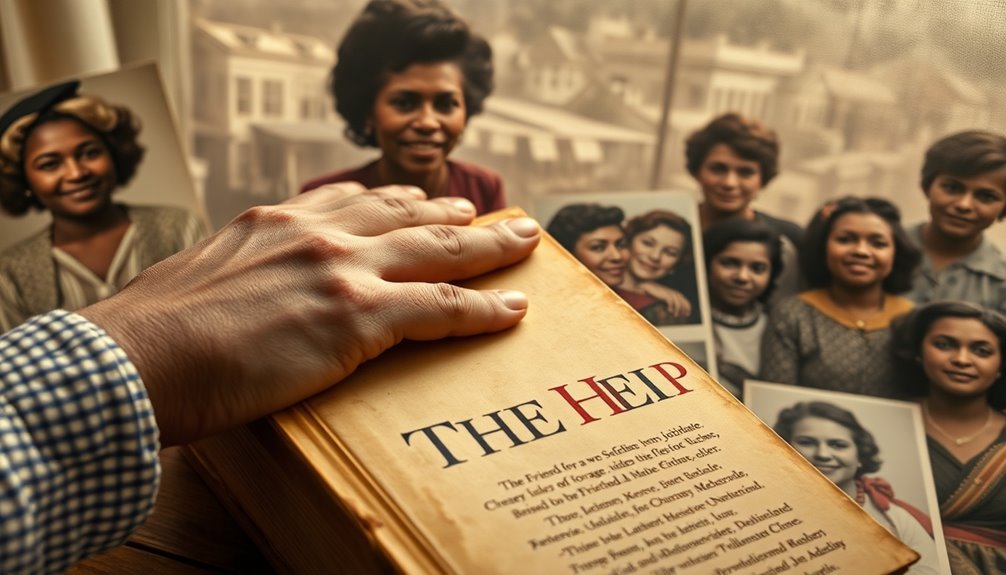In "The Help," Kathryn Stockett artfully explores the powerful themes of friendship and courage set against the backdrop of 1960s Mississippi. You'll meet three strong characters: Skeeter, Aibileen, and Minny, who challenge social norms while confronting racism and inequality. Their collaboration reveals the strength found in solidarity, as they dare to share their stories. You'll appreciate the rich, descriptive language that immerses you in their lives and struggles. Although the novel has faced some critique for its portrayal of complex issues, its cultural impact remains significant. Stick around to uncover more about its powerful legacy and insights.
Overview of the Novel

In "The Help," Kathryn Stockett transports you to Jackson, Mississippi, in 1962, a time rife with racial tensions and social upheaval. The novel centers on the intertwined lives of three remarkable characters: Skeeter, Aibileen, and Minny.
Skeeter, a young white woman with aspirations of becoming a writer, dares to challenge the status quo by documenting the experiences of black maids. Aibileen, a devoted maid, raises white children while grappling with her personal losses. Meanwhile, Minny, known for her fierce personality and exceptional cooking, stands as a symbol of courage amidst adversity. Coates' exploration of systemic racism in his work complements the struggles faced by these characters. During this turbulent era, the notion of resilience amid adversity becomes increasingly relevant as individuals strive to maintain their dignity against oppression.
Through their friendship, these women navigate a world fraught with discrimination and injustice. Stockett employs storytelling as a powerful tool for empowerment, allowing Aibileen and Minny to share their truths, which defy societal norms.
The narrative bravely confronts the racial tensions of the era, illustrating the resilience of its characters. As you explore "The Help," you'll witness the transformative power of friendship and the courage it takes to stand up against a divided society. The film adaptation also sparks important conversations about race in America, enhancing the novel's cultural significance.
This engaging tale not only entertains but also sparks essential conversations about race and representation in literature.
Character Insights
Characters in "The Help" are richly developed, each bringing their unique perspectives to the narrative. Skeeter Phelan, a recent Ole Miss graduate, challenges societal norms by investigating the truth about her missing maid, Constantine, and documenting the experiences of black maids in Jackson, Mississippi. Her courage to confront these issues sparks a transformative friendship with Aibileen and Minny. This collaboration embodies the spirit of empowerment through shared narratives, reflecting the strength found in collective action. The courage shown by Skeeter, Aibileen, and Minny echoes the acts of resistance seen in historical movements against oppression.
Aibileen, a wise and nurturing maid, has raised 17 white children while grappling with the personal loss of her son. Her strength and love are palpable as she provides care, becoming a voice for those often silenced, reminiscent of the resilience displayed by resistance fighters during World War II.
Minny, known for her sass and exceptional cooking, faces employment challenges due to her outspoken nature but embodies resilience throughout the story.
Together, they navigate the oppressive social hierarchy, showcasing the power of friendship and collaboration across racial lines. Their efforts reflect a collective pursuit of social change, mirroring the early stirrings of the civil rights movement. This pursuit resonates with the actions of unsung trailblazers who have historically challenged societal norms for justice and equality.
In contrast, secondary characters like Hilly Holbrook serve as antagonists, reinforcing the prejudices that shape their world. The interactions between these characters create a compelling exploration of courage and connection amidst societal challenges.
Key Themes Explored

The Help dives deep into themes of racism and social injustice, shedding light on the systemic inequalities that black maids faced in 1960s Mississippi. Through the powerful narratives of Aibileen, Minny, and Skeeter, you witness the strength of friendship and solidarity among women as they unite to share their stories and challenge societal norms.
Key themes you'll discover include:
- Storytelling as Empowerment: The act of sharing personal experiences becomes a catalyst for social change, resembling the impact of HeLa cells in advancing medical ethics.
- Motherhood's Complexities: Aibileen's nurturing role highlights the emotional depth of caregiving, contrasting sharply with Mae Mobley's neglect. This dynamic reflects the broader overlooked contributions of caregivers in shaping society.
- Courage in Confrontation: Characters risk their safety and social standing, bravely standing against prejudice, much like Louis Zamperini's resilience amid WWII adversity.
- Solidarity Against Racism: The bond among the women illustrates how collective action can challenge social injustice.
Additionally, the book exemplifies how embracing inner strength can reveal untapped potential, inspiring readers to confront societal norms with courage.
Through these themes, The Help invites you to reflect on the courage it takes to confront deeply rooted societal norms, while also celebrating the transformative power of friendship and the shared experiences that can bridge divides.
The Writing Style
Kathryn Stockett's writing style in "The Help" immerses you in the vibrant world of 1960s Mississippi, using rich, descriptive language that brings both the setting and the characters to life.
You feel the emotional landscapes of Aibileen and Minny as they navigate the complexities of race and social issues. Each character has a distinct voice, allowing you to connect deeply with their unique perspectives, which adds authenticity and depth to the narrative.
Stockett skillfully balances humor and social commentary, making you laugh while also prompting reflection on the serious themes of racism and inequality that permeate everyday life.
The detailed descriptions create vivid imagery, highlighting the stark contrasts between the lives of black maids and their white employers.
While the prose flows smoothly, some aspects of the dialogue and characterization have stirred debates about authenticity and representation, particularly concerning African American voices. Additionally, the exploration of immigrant experiences parallels the challenges faced by characters in other narratives, showcasing resilience and the quest for a better future.
Cultural Impact and Legacy

Significant conversations around race and representation have emerged from "The Help," cementing its role as a pivotal work in contemporary literature. This novel has sparked national interest and debate regarding the historical experiences of African American maids, and its cultural impact reaches far beyond its pages.
While many appreciate its themes of friendship and courage, some critics argue that it oversimplifies complex racial issues and reinforces stereotypes.
Consider these key points about its legacy:
- It amplifies discussions on racial inequality and the portrayal of domestic workers.
- The film adaptation in 2011 broadened its reach, making the story more accessible.
- Readers often pair "The Help" with authentic narratives, like "Coming of Age in Mississippi," to deepen their understanding of the Civil Rights Movement.
- It highlights the importance of privilege and authentic storytelling in literature.
Conclusion
In "The Help," you'll find a world bursting with courage and unbreakable bonds of friendship that'll leave your heart soaring like a kite on a windy day. The characters leap off the pages, making you laugh, cry, and reflect on the complexities of human relationships. This novel isn't just a read; it's an unforgettable experience that'll stick with you long after you've turned the last page. Immerse yourself in this powerful story and feel its impact resonate within you.



